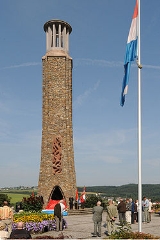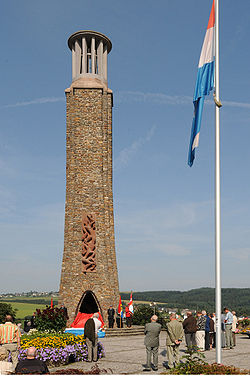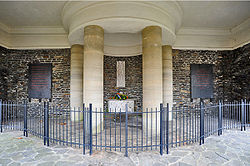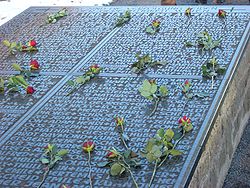
1942 Luxembourgian general strike
Encyclopedia
The Luxembourgian general strike of 1942 was a pacific resistance movement organised within a short time period to protest against a directive that conscripted Luxembourg
youth into the Wehrmacht
. A national general strike
, originating mainly in Wiltz
, paralysed the country and led to the occupying German authorities responding violently by sentencing 21 strikers to death.

Gustav Simon
, developed a robust policy of germanization. Furthermore, on August 30, 1942, Gustav Simon announced that all Luxembourger males born between 1920 and 1927 were to be conscripted into the Wehrmacht to fight against the Allies
.
with a gathering of local Luxembourg town officials, led by local town officials Michel Worré and Nicolas Müller, refusing to go to work. These were gradually joined by other local workers, among them the employees of IDEAL Lederwerke Wiltz, a large industrial tannery belonging to the Adler & Oppenheimer group before "aryanisation". News on the strike spread rapidly.
Soon thereafter, workers from the southwestern industrial towns of Schifflange
and Differdange
were alerted, and also refused to go to work. In Schifflange, Hans Adam, a worker of German origins sounded the alarm across the valley to alert all workers.
In Differdange, news of the strike spread throughout the workforce by word of mouth, and increased in intensity on September 1. On September 2, 156 mill workers refused to take their shift, and many of those who were already working stopped. The German directors of the mill warned the millworkers that they could be killed for their actions. A few workers got back to work, but approximately 50 still refused, and declared they were on strike. At 10 a.m., German authorities reacted and designated who they held as responsible for the situation: Jean-Paul Schneider, Nicolas Betz,
Alphonse Weets, Robert Mischo, René Angelsberg, and Ernest Toussaint. The six men were arrested, tried by a special tribunal, sentenced to death, and deported to the Hinzert concentration camp where they were shot. Their families were sent to prison and work camps in Germany.
The strike spread also to Esch-sur-Alzette
, the capital of the Luxembourg mining area, all aspects of the administration were paralysed, including administration, agriculture, industry and education structures..
The central post office in Luxembourg received rumours of the strike in the morning, and received formal confirmation of the strike by early afternoon, which disrupted the distribution of mail that evening and the following day.
Throughout the country, schoolchildren were kept away from school, teachers refused to teach, laborers refused to work, there was no or little production of steel, milk, and other products.
Although the exact number of strikers is unknown, the movement did have a strong effect on the country and the occupying forces, and revitalized resistance movements. The strike was also widely publicized internationally by the allied press.
 Fearing a further escalation of protests, German authorities decided to react in the harshest way to the strike. Within hours, the strike leaders were rounded up and interrogated by the Gestapo
Fearing a further escalation of protests, German authorities decided to react in the harshest way to the strike. Within hours, the strike leaders were rounded up and interrogated by the Gestapo
. They were formally arrested soon thereafter, on September 1, and interned in local prisons. 20 strike leaders were summarily tried by a special tribunal (Standgericht) and sentenced to death and transferred to the Hinzert concentration camp
where they were shot and buried in an unmarked grave. Hans Adam, who had rung the alarm in Schifflange and had German origins, was considered to be a traitor and was thus decapitated. 200 Luxembourgers were arrested, 83 were tried by the special tribunal and transferred to the Gestapo. 290 high school children, boys and girls, were arrested and sent to re-education camps in Germany, as were 40 ARBED
trainees and 7 young postmen.
The first two strikers to be shot, on September 2, 1942, at 6.30 p.m., were Michel Worré and Nicolas Müller, from Wiltz. Their last words
, according to an SS who witnessed the execution, were "Vive Lëtzebuerg" (Long live Luxembourg!).
A series of black on red posters were then posted throughout Luxembourg announcing the death of the strikers as a consequence of the strike, bearing the names, occupation, and residency of each victim. Their families, including their children, were subsequently transferred to work camps, many in Silesia
, under very harsh conditions.
 The Luxembourg spelling of the names is respected
The Luxembourg spelling of the names is respected
In 1965, a lighthouse-shaped "National Monument to the Strike" was opened in Wiltz. Luxembourg's most famous 20th-century sculptor Lucien Wercollier
created the two reliefs on the lighthouse displayed there. Wercollier was himself imprisoned at the Hinzert concentration camp
.
Luxembourg
Luxembourg , officially the Grand Duchy of Luxembourg , is a landlocked country in western Europe, bordered by Belgium, France, and Germany. It has two principal regions: the Oesling in the North as part of the Ardennes massif, and the Gutland in the south...
youth into the Wehrmacht
Wehrmacht
The Wehrmacht – from , to defend and , the might/power) were the unified armed forces of Nazi Germany from 1935 to 1945. It consisted of the Heer , the Kriegsmarine and the Luftwaffe .-Origin and use of the term:...
. A national general strike
General strike
A general strike is a strike action by a critical mass of the labour force in a city, region, or country. While a general strike can be for political goals, economic goals, or both, it tends to gain its momentum from the ideological or class sympathies of the participants...
, originating mainly in Wiltz
Wiltz
Wiltz is a commune with city status in north-western Luxembourg, capital of the canton Wiltz. Wiltz is situated on the banks of the river Wiltz. It was also a battleground in the Battle of the Bulge, near the end of World War II...
, paralysed the country and led to the occupying German authorities responding violently by sentencing 21 strikers to death.

Origins
Following the German invasion of Luxembourg on May 10, 1940, Luxembourg was placed under military occupation. In August 1942, German authorities announced the formal annexation of Luxembourg by the Third Reich into Nazi Germany, or Greater German Empire, as part of the Gau Moselland. The Luxembourg population was declared to be German and was to use German as its only language; the German authorities, under the orders of the GauleiterGauleiter
A Gauleiter was the party leader of a regional branch of the NSDAP or the head of a Gau or of a Reichsgau.-Creation and Early Usage:...
Gustav Simon
Gustav Simon
Gustav Simon was, as the Nazi Gauleiter in the Moselland Gau from 1940 until 1944, the Chief of the Civil Administration in Luxembourg, which was occupied at that time by Nazi Germany....
, developed a robust policy of germanization. Furthermore, on August 30, 1942, Gustav Simon announced that all Luxembourger males born between 1920 and 1927 were to be conscripted into the Wehrmacht to fight against the Allies
Allies
In everyday English usage, allies are people, groups, or nations that have joined together in an association for mutual benefit or to achieve some common purpose, whether or not explicit agreement has been worked out between them...
.
The strike and its consequences
Reaction to the policies was swift among the Luxembourg population, especially against the forced conscription policy. Within hours, a number of Luxembourgers discussed possibilities and decided to organize a general strike. Leaflets calling for the strike were printed, and distributed clandestinely throughout the country by resistants. On August 31, 1942, the strike officially began in the northern Ardennes town of WiltzWiltz
Wiltz is a commune with city status in north-western Luxembourg, capital of the canton Wiltz. Wiltz is situated on the banks of the river Wiltz. It was also a battleground in the Battle of the Bulge, near the end of World War II...
with a gathering of local Luxembourg town officials, led by local town officials Michel Worré and Nicolas Müller, refusing to go to work. These were gradually joined by other local workers, among them the employees of IDEAL Lederwerke Wiltz, a large industrial tannery belonging to the Adler & Oppenheimer group before "aryanisation". News on the strike spread rapidly.
Soon thereafter, workers from the southwestern industrial towns of Schifflange
Schifflange
Schifflange is a commune and town in south-western Luxembourg. It is part of the canton of Esch-sur-Alzette, which is part of the district of Luxembourg., the town of Schifflange, which lies in the west of the commune, has a population of 7,849....
and Differdange
Differdange
Differdange is a commune with city status in south-western Luxembourg. Differdange is an industrial city that was home to much of Luxembourg's steel production, and lies near the borders with Belgium and France...
were alerted, and also refused to go to work. In Schifflange, Hans Adam, a worker of German origins sounded the alarm across the valley to alert all workers.
In Differdange, news of the strike spread throughout the workforce by word of mouth, and increased in intensity on September 1. On September 2, 156 mill workers refused to take their shift, and many of those who were already working stopped. The German directors of the mill warned the millworkers that they could be killed for their actions. A few workers got back to work, but approximately 50 still refused, and declared they were on strike. At 10 a.m., German authorities reacted and designated who they held as responsible for the situation: Jean-Paul Schneider, Nicolas Betz,
Alphonse Weets, Robert Mischo, René Angelsberg, and Ernest Toussaint. The six men were arrested, tried by a special tribunal, sentenced to death, and deported to the Hinzert concentration camp where they were shot. Their families were sent to prison and work camps in Germany.
The strike spread also to Esch-sur-Alzette
Esch-sur-Alzette
Esch-sur-Alzette is a commune with city status, in south-western Luxembourg. It is the country's second city, and its second-most populous commune, with a population of 29,853 people...
, the capital of the Luxembourg mining area, all aspects of the administration were paralysed, including administration, agriculture, industry and education structures..
The central post office in Luxembourg received rumours of the strike in the morning, and received formal confirmation of the strike by early afternoon, which disrupted the distribution of mail that evening and the following day.
Throughout the country, schoolchildren were kept away from school, teachers refused to teach, laborers refused to work, there was no or little production of steel, milk, and other products.
Although the exact number of strikers is unknown, the movement did have a strong effect on the country and the occupying forces, and revitalized resistance movements. The strike was also widely publicized internationally by the allied press.
German reaction to the Strike

Gestapo
The Gestapo was the official secret police of Nazi Germany. Beginning on 20 April 1934, it was under the administration of the SS leader Heinrich Himmler in his position as Chief of German Police...
. They were formally arrested soon thereafter, on September 1, and interned in local prisons. 20 strike leaders were summarily tried by a special tribunal (Standgericht) and sentenced to death and transferred to the Hinzert concentration camp
Hinzert concentration camp
Hinzert was a Nazi concentration camp located in Rhineland-Palatinate, Germany, 30 km from the Luxembourg border....
where they were shot and buried in an unmarked grave. Hans Adam, who had rung the alarm in Schifflange and had German origins, was considered to be a traitor and was thus decapitated. 200 Luxembourgers were arrested, 83 were tried by the special tribunal and transferred to the Gestapo. 290 high school children, boys and girls, were arrested and sent to re-education camps in Germany, as were 40 ARBED
Arbed
ARBED was a major Luxembourg-based steel and iron producing company. Created in 1911 after the merger of three steel producing companies, ARBED was a major actor in the economic history of the Grand-Duchy until it merged in 2002 with two other European steel companies to create Arcelor.- Origins ...
trainees and 7 young postmen.
The first two strikers to be shot, on September 2, 1942, at 6.30 p.m., were Michel Worré and Nicolas Müller, from Wiltz. Their last words
Last words
Last words are a person's final words spoken before death.Last Words may also refer to:* Last Words , an Australian punk band* Last Words , a memoir by George Carlin* Last Words , a 1968 short film directed by Werner Herzog...
, according to an SS who witnessed the execution, were "Vive Lëtzebuerg" (Long live Luxembourg!).
A series of black on red posters were then posted throughout Luxembourg announcing the death of the strikers as a consequence of the strike, bearing the names, occupation, and residency of each victim. Their families, including their children, were subsequently transferred to work camps, many in Silesia
Silesia
Silesia is a historical region of Central Europe located mostly in Poland, with smaller parts also in the Czech Republic, and Germany.Silesia is rich in mineral and natural resources, and includes several important industrial areas. Silesia's largest city and historical capital is Wrocław...
, under very harsh conditions.
Executed persons

- Strikers executed on September 2, 1942
- Worré, Michel - Head of the local economic council, Wiltz
- Müller, Nicolas - Secretary of the local authority, Wiltz
- Strikers executed on September 3, 1942
- Kons, Nicolas - Postal Underinspector, Luxembourg
- Meyers, Charles - Teacher, Wiltz
- Ewen, Josy - Teacher, Wiltz
- Brück, Alfred - Teacher, Wiltz
- Lommel, Célestin - Teacher, Wiltz
- Weets, Alphonse - Turner, Differdange
- Schneider, Jean-Paul - Toolmaker, Differdange
- Toussaint, Ernest - Miner, Differdange
- Betz, Nicolas - Toolmaker, KahlerKahler, LuxembourgKahler is a village in the commune of Garnich, in south-western Luxembourg. , the village has a population of 188....
- Strikers executed on September 4, 1942
- Zeimes, Léon - Typographer, ItzigItzigItzig may mean:* The Itzig family, famous for its contribution to Jewish and German cultural history* Julius Eduard Hitzig, born Isaac Elias ItzigPlace names:* Itzig, Luxembourg...
- Mischo, Robert - Worker, Differdange
- Angelsberg, René - Worker, Differdange
- Schroeder, Jean - Postman, Luxembourg City
- Zeimes, Léon - Typographer, Itzig
- Strikers executed on September 5, 1942
- Dax, Michel - Railway worker, EttelbruckEttelbruckEttelbruck is a commune with city status in central Luxembourg, with a population of approximately 7,500. As of 2005, the town of Ettelbruck itself, which lies in the east of the commune, has a population of 6,191. The town of Warken and Grentzingen are also within the commune...
- Heiderscheid, Emile - Worker, DiekirchDiekirchDiekirch is a commune with city status in north-eastern Luxembourg, capital city of the canton Diekirch and the district of Diekirch. The city is situated on the banks of the Sauer river....
- Schmit, Alphonse - Professor, EchternachEchternachEchternach is a commune with city status in the canton of Echternach, which is part of the district of Grevenmacher, in eastern Luxembourg. Echternach lies near the border with Germany, and is the oldest town in Luxembourg....
- Thull, Jean - Railway worker, Ettelbruck
- Dax, Michel - Railway worker, Ettelbruck
- Strikers executed on September 9, 1942
- Biren, Eugène - Schifflange
- Other executed stiker
- Adam, Henri - Worker, Schifflange, executed by decapitation in CologneCologneCologne is Germany's fourth-largest city , and is the largest city both in the Germany Federal State of North Rhine-Westphalia and within the Rhine-Ruhr Metropolitan Area, one of the major European metropolitan areas with more than ten million inhabitants.Cologne is located on both sides of the...
.
- Adam, Henri - Worker, Schifflange, executed by decapitation in Cologne
Commemoration of the Strike
The 1942 Luxembourg general strike strongly marked Luxembourg's resistance to the German occupier, and represents one of the proudest moments of the history of the Grand-Duchy. Each year, the Strike is commemorated on August 31 by the head of state and government officials.In 1965, a lighthouse-shaped "National Monument to the Strike" was opened in Wiltz. Luxembourg's most famous 20th-century sculptor Lucien Wercollier
Lucien Wercollier
Lucien Wercollier was a sculptor from Luxembourg.While he worked primarily in bronze and marble, some of his work is sculpted in wood, alabaster, stone and onyx. His public monuments in bronze and marble are of particular importance...
created the two reliefs on the lighthouse displayed there. Wercollier was himself imprisoned at the Hinzert concentration camp
Hinzert concentration camp
Hinzert was a Nazi concentration camp located in Rhineland-Palatinate, Germany, 30 km from the Luxembourg border....
.
See also
- Dutch strike against deportation of Dutch Jews on 25 february 1941, the 'February strikeFebruary strikeThe 1941 February Strike, also known as 'The Strike of February 1941', was a general strike organized during World War II in the Netherlands against the anti-Jewish measures and activities of the Nazis. Its direct causes were the pogroms held by the Germans in the Jewish neighbourhood of Amsterdam....
'

